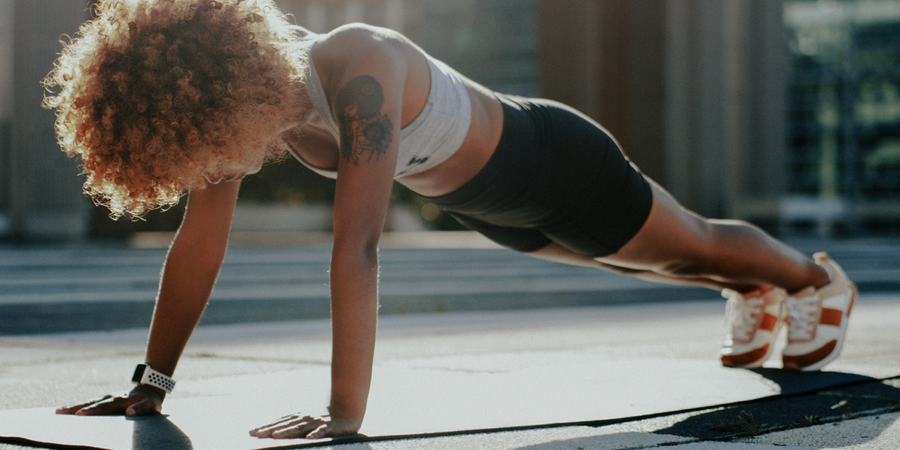
Build a Strong Upper Body With This Push Day Workout
By Jenessa Connor
Adding structure to your fitness routine can make your workouts more purposeful and efficient, minimize the risk of injury, and yield even better results. One simple way to do this is a rotating daily schedule of push, pull, and leg workouts.
Help your muscles recover and repair faster with the quick-releasing protein in LADDER Whey!
What Is a Push Day?
As the name suggests, a push day workout consists of upper body exercises that utilize a pushing motion. These exercises primarily target the chest, shoulders, and triceps. (Pull exercises, which engage the back, biceps, and forearms, are reserved for another day.) While some people may choose to incorporate leg exercises on a push day, others dedicate a separate day to lower-body work.
What Are the Benefits of Push Day Workouts?
Pushing is a cornerstone of functional fitness. To simply get off the ground, you must be able to push up your body weight. “Performing a broad range of push exercises helps maintain a strong and healthy body," says LADDER Fitness Expert Amanda Lopez. “Not just for your muscles, but your bones and joints as well."
Dedicating specific days to push day workouts allows you to work harder and maximize rest. “The idea behind separating push and pull days is to work specific related muscle groups together and to exhaust those muscles," Lopez says. “Therefore, you won't be training the same muscle groups two days in a row, which can help optimize recovery time."
What Are Some Push Day Exercises?
Chances are, you're already doing push day exercises as part of your regular fitness routine. In case you need some ideas, here are a few push day workout staples.
1. Push-up
- Assume a high-plank position with your feet together, your body straight from head to heels, and your hands in line with (but slightly wider than) your shoulders. Engage both your glutes and your core to lock your body into position.
- Keeping your elbows tucked toward your body and your head neutral, lower your torso until your chest is within a few inches of the floor.
- Pause, and then push yourself back up to the starting position.
2. Shoulder press
- Stand tall with your feet hip-width apart and hold a pair of dumbbells in front of your shoulders with your elbows tucked in and palms facing each other.
- Keeping your core engaged and back flat, press the weights directly above your shoulders until your arms are straight and your biceps are next to your ears.
- Pause, then lower the weights back to the starting position.
3. Dumbbell bench press
- Lie on a sturdy, padded bench, feet flat on the floor, holding two heavy dumbbells at arm's length over your chest, palms facing forward.
- Keeping your core engaged, lower back pressed into the bench, and upper arms at a 45 degree angle to your body, slowly lower the dumbbells until your upper arms are parallel to the floor.
- Pause, and then push the weights back to the starting position.
4. Dumbbell chest fly
- Lie on a flat bench holding a pair of dumbbells at arm's length above your chest, palms facing each other.
- Keeping your core engaged, lower back pressed into the bench, and elbows slightly bent, slowly lower the dumbbells directly out to your sides until you feel a deep stretch in your chest.
- Pause, and then slowly reverse the move, returning to the starting position.
5. Dumbbell overhead triceps extension
- Sit on a bench or chair, cupping one end of a dumbbell in both hands directly overhead. This is the starting position.
- Keeping your chest up, core engaged, and back flat, lower the weight behind your head without moving your upper arms.
- Pause, and then press the weight back up to the starting position.
6. Dumbbell lateral raise
- Stand tall with your feet hip-width apart and your arms at your sides, holding a dumbbell in each hand.
- Raise your arms to your sides until they're level with your shoulders. Keep your palms facing downward.
- Pause, and then lower the weights back to the starting position.
How Should I Structure My Push Day?
It's generally a good idea to perform your heaviest lifts at the beginning of a workout, but the key is to stick to pushing exercises. As for the rest of your weekly workout schedule, some people find it helpful to have designated push and pull days and combine lower body and core work in one workout. So, for example, you could structure your routine as follows:
- Monday: Push day workout
- Tuesday: Pull day workout
- Wednesday: Legs and core workout
- Thursday: Push day workout
- Friday: Pull day workout
- Saturday: Legs and core workout
- Sunday: Rest
“You don't have to have a rest day in between push and pull days because they work different muscles, so you won't be working the same muscles back to back," explains Lopez.